Results
In this study 1461 individuals of 45 species of butterflies and burnet moths was observed, the dominating species group was grassland generalists with 861 individuals. The number of individuals varied between 3 and 282 per site and species between 2 and 25.
Butterfly and burnet moth density at local level
The recorded density of butterflies and burnet moths followed a similar pattern through all four species groups, with the highest density in road verges and non-grazed grasslands, except from field margin specialist that had highest density in road verges and field margins. Lowest density occurred in forest habitats and arable fields.
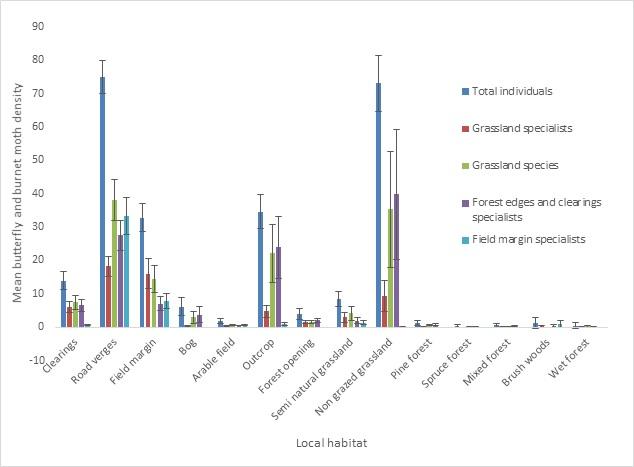
The differences in species richness between habitats was tested with an abundance test that calculate how species richness are affected by increasing sampling size in each habitat. The results showed that increasing the sample size had the greatest impact on species richness in the field margins and the least impact at outcrops. The result did also show that species richness in clearings, bogs, non-grazed grasslands, pine forest, and arable land had a similar pattern of increase with increasing sample size.
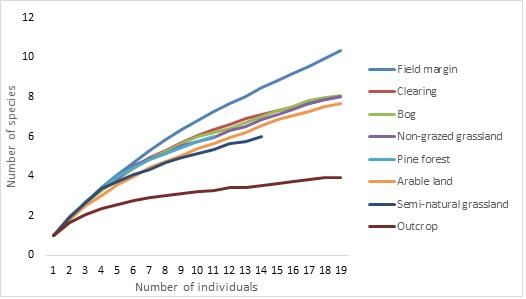
The estimation of species richness was complemented with the completeness test, to see how well inventoried butterflies and burnet moths were represented of the species in each habitat. The estimation of species richness and completeness supported each other regard to species richness, which indicate that sampled butterflies and burnet moths is representing the species richness in each habitat. The high value of completeness indicate that there is a low chance to find a new species if the sample size would increase with one individual.
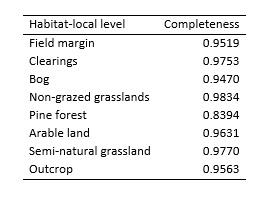
Local habitat qualities
To investigate how the local quality of habitat affected butterfly density, a number of variables were tested with a generalized linear model. The results showed that the important factors for high local habitat quality for butterflies and burnet moths are mainly richness of vascular plants, nectar, herbs and high sward height. Negative factors for habitat quality were especially conifer trees and bushes, sprigs, regrowth clearing and grass.
Highest mean value of species of vascular plants were found in semi-natural grasslands and non-grazed grasslands. Nectar sources were mainly occurring at road verges, field margins, semi-natural grasslands, non-grazed grasslands and forest openings. Herbs was dominating in field margins, semi-natural- and non-grazed grasslands, but also road verges, clearings, arable fields and forest openings had a high proportion of herbs. Variables with negative effect were in general highest in pine-, spruce-, and mixed forest, with the highest amount of conifer trees and bushes, sprigs and regrowth clearings and bushes. Amount of grass was highest in clearings, arable fields, brush woods and wet forests. These habitats together with forest openings had also the highest sward heights, which was a positive variable.
Butterfly and burnet moth occurrence at local level
There were clear pattern of hotspots for butterfly and burnet moth density in the sampling plots. The pattern followed the result of good habitat quality, hotspots where were high richness of vascular plants, nectar and herbs occur. Clearings, non-grazed grasslands, grassy elements and semi-natural grasslands was real hotspots. Depending on the composition of habitat types in the sampling area, hotspots and density was different among the same type of habitat between the sampling areas. Clearings with high vegetation and richness of nectar were a hotspot for butterflies and burnet moths (Fig. A) compare to clearing with less nectar, where instead adjacent linear grassy element were more of a hotspot with high density (Fig. B). Bogs had higher density than the dense surrounding forest (Fig. C). Non-grazed grasslands and road verges were hotspots with high density in areas dominated of forest (Fig. D-E). The density of butterflies and burnet moths increased substantially in forest with grassy elements compared to forest without (Fig. F).
A sampling area placed at an arable field with surrounding matrix dominated of arable land had less density of butterflies (Fig. G, I) than arable field surrounded of forest and pasture (Fig. H). In all areas with arable land, grassy linear elements was important for butterfly density (Fig. H-I). Semi-natural grasslands surrounded of both forest and arable land had an even distribution of butterflies and burnet moths over the whole area (Fig. J), compared to semi-natural grasslands only surrounded of arable land were instead highest density occurred around bushes and trees (Fig. K-L).
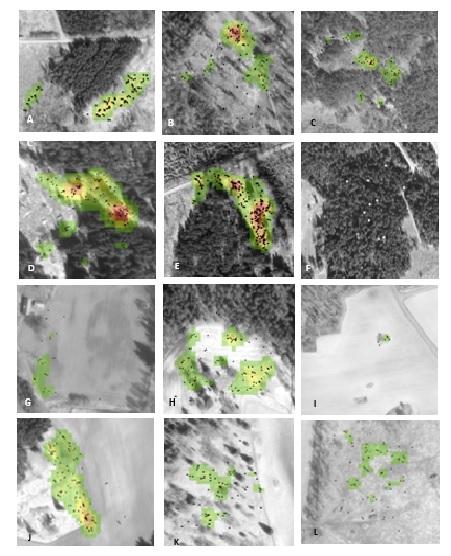
Effect of landscape composition
The generalized linear model shows the effect of the surrounding matrix on the total number of individuals and on each species group; grassland specialists, grassland generalists, forest edges, clearings specialists and arable field margin specialists. The effect of each habitat type were tested at different landscape scales (radii of 500 m and 3000 m), and the result show that the largest impact of landscape composition were at 3000 m scale on butterfly and burnet moth density.
The result of the generalized linear model for the total number of individuals showed a similar pattern between the two scales. Semi-natural grasslands, water, improved grasslands and arable land, had more or less a significant negative impact and differed from deciduous forest, clearings, mixed forest, young forest and bogs that positively affected density of butterflies and burnet moth. Semi-natural grasslands and coniferous forest had a more positive impact at 500 m scale than 3000 m.
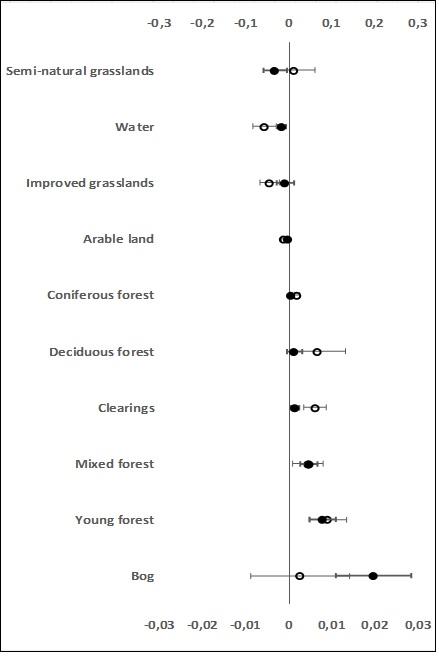
For grassland specialist (Fig. A), clearings, improved grasslands, mixed forest, deciduous forest and young forest had a significantly more positive effect on density at the 3000 m scale than semi-natural grasslands, bogs, water, arable fields and coniferous forest. At 500 m scale, semi-natural grassland had a weak positive effect as also coniferous forest. Improved grassland had a negative effect and were significantly different from mixed forest, deciduous forest and young forest that had a positive effect. Grassland generalists (Fig. B) followed a similar pattern as grassland specialists at 3000 m scale, but at the 500 m scale clearings and young forest had a significant higher positive effect than semi-natural grasslands, improved grasslands and coniferous forest.
Forest edges and clearings specialist (Fig. C) responded similar to grassland generalists and specialists with a significant higher positive impact of forest habitats than semi-natural grasslands, arable field and also improved grasslands at both 500 m and 3000 m scale. Arable field margin specialists (Fig. D) was the group that greatly differed from the other three species groups. Forest habitats as bogs, mixed forest, young forest, clearings, coniferous forest, water and also semi-natural grasslands had a significantly higher negative effect on density than arable fields, deciduous forest and improved grasslands at a 3000 m scale. At the 500 m scale improved grasslands instead had a negative effect and significantly differed from young forest and semi-natural grasslands that had a positive impact.
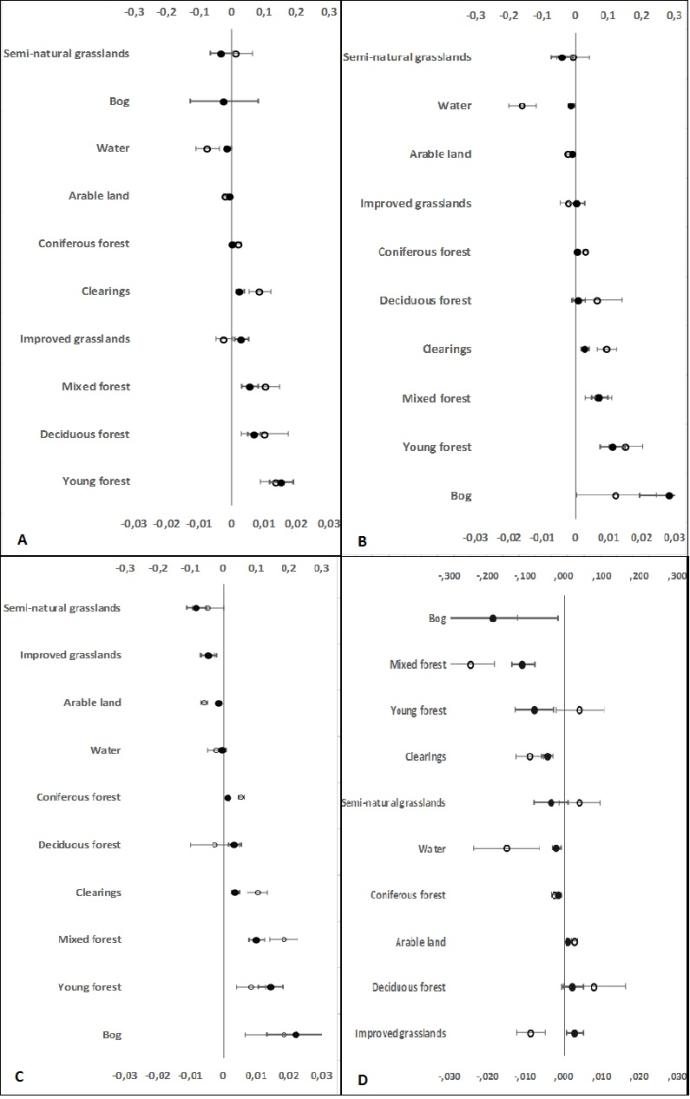
Responsible for this page:
Director of undergraduate studies Biology
Last updated:
